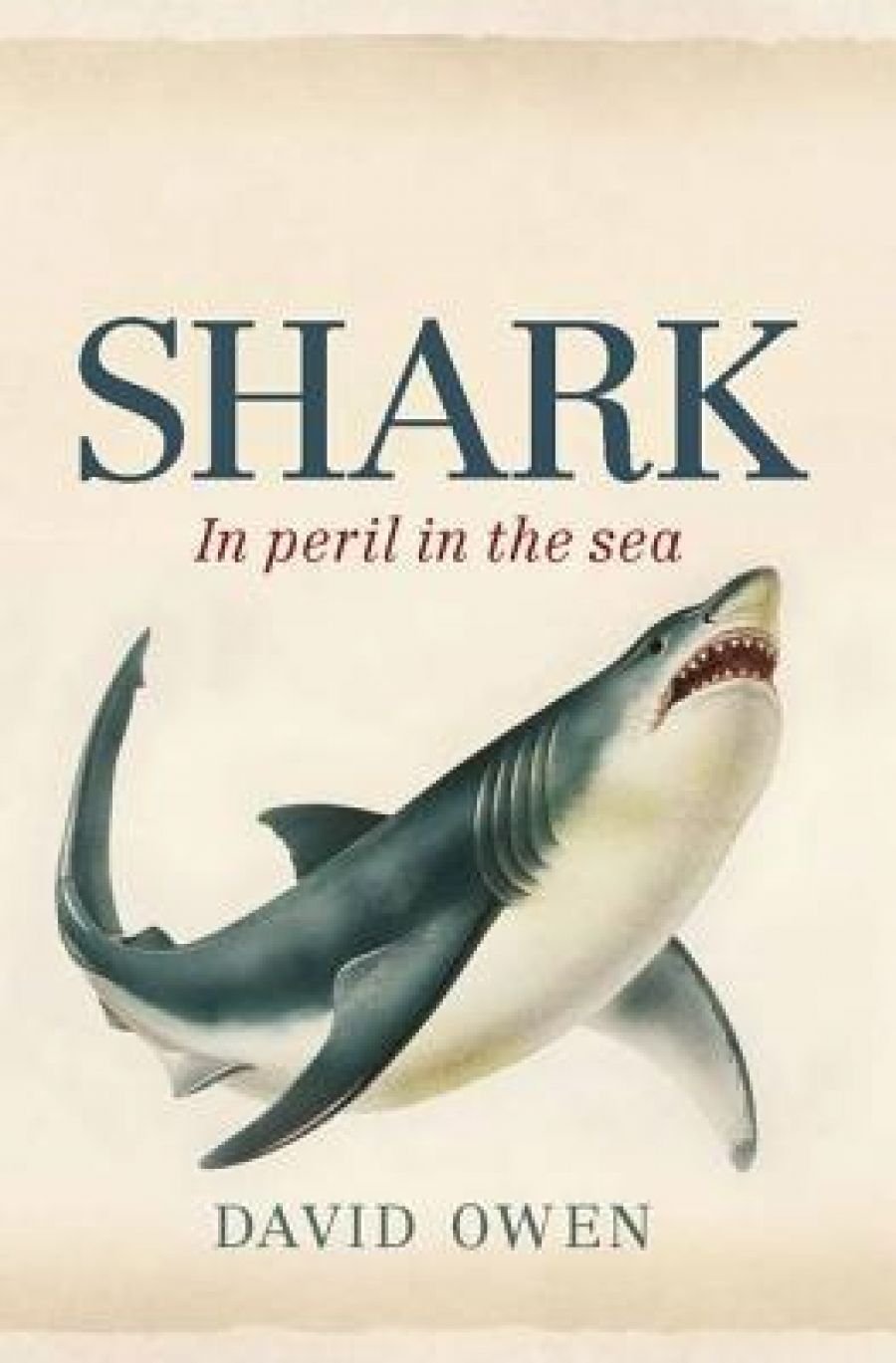
- Free Article: No
- Contents Category: Natural History
- Review Article: Yes
- Article Title: If only they were easier to love
- Online Only: No
- Custom Highlight Text:
The press release for David Owen’s latest book describes it as a ‘thoroughly researched’ work by a shark ‘outsider’ that aims to ‘comprehensively overturn our negative and damaging perceptions of sharks’. I cannot claim expert knowledge of sharks, but personal experience makes me a suitable subject on which to measure the author’s effectiveness. When I was a child, one of my sisters was bitten in shallow water by a shark that had breached a netted beach in North Queensland. Although her injuries were not life-threatening, the resulting panic had a lasting effect: I rarely swim in the ocean, and have a healthy respect for sharks.
- Book 1 Title: Shark
- Book 1 Subtitle: In peril in the sea
- Book 1 Biblio: Allen & Unwin $35 hb, 328 pp
Shark: In Peril in the Sea opens with a mini-catalogue of shark attacks and incidents, and the many and varied theories on why sharks attack humans. One expects a study of sharks to reference attacks on humans; such material goes with the territory and, as Owen points out, retains a morbid fascination to which the success of Peter Benchley’s Jaws (1974) attests. Nevertheless, Owen’s assertion that ‘a totally incorrect perception of sharks, but one that stubbornly persists, is that they are inherently a danger to human beings’ failed to convince this reader, given the terrifying accounts of fatalities and near misses.
After the author deals with the worst of their behaviour, he sets about proving there is more to sharks than feeding frenzies, dorsal fins, and rows of dangerous teeth. Owen discusses indigenous practices such as ‘shark calling’, ‘shark worship’, and some traditional preparations of shark meat; in particular, Icelandic skyrhakarl, which, in order to remove the high concentrations of ammonia and trimethylane oxide (anti-freeze) from the flesh, is pressed flat in a large gravel hole in the ground until putrid, then dried for a further two to three months before it is ready for consumption. It came as no surprise to discover that the taste of ‘skyrhakarl has been known to cause an involuntary gagging reaction’.
While nothing can distract me from the thought of all of those teeth, the plundering of the earth’s oceans to satisfy human appetites highlights the importance of Owen’s aim. The number of sharks being killed per year for their fins, meat, liver oil, and pharmaceutical products is estimated at approximately 150 million, a frightening figure when one considers the slow breeding and maturation rates of sharks. It is equally disturbing to discover that this figure does not include the large percentage of illegal ‘finning’, incidental catches, and recreational catches. Overfishing and destructive catch methods may have already forced species we didn’t even know existed into extinction, and ruined whole ocean habitats that were essential to their survival. We have already proven ourselves capable of ignoring extinctions in our immediate environment. As the oceans are, to a great extent, out of sight, out of mind, it is easy to understand the danger complacency poses for sharks. Owen is correct when he urges a change in attitude. We must protect vulnerable species of shark with the same commitment that we afford whales. Otherwise we may witness another human-induced mass extinction. Owen lists approximately five to six organisations worldwide that are dedicated to shark conservation. One wonders if it might be worth their while pooling their knowledge and resources.
Shark, though elegantly produced, suffers from an identity crisis: it is neither general natural history reader nor textbook. The sketch of a shark against a cream background on the dustcover has a reference-book quality. Internally, the use of sketches at the beginning of each chapter and photo-plates throughout conforms to Owen’s previous titles: Thylacine: The ragic tale of the Tasmanian tiger (2003) and Tasmanian Devil: A unique and threatened animal (2005). There are anecdotes, little-known indigenous practices and a diverting discussion of the etymology of the word itself; but, at 104 pages, the comprehensive descriptions of Sharks, Skates, Rays, and Chimaeras make Chapter Six too long. This ‘representative selection’ does not sit comfortably in a book marketed toward general readership. It might have been advantageous to keep the species descriptions shorter or to disperse some of the information throughout the book, rather than offering it in one indigestible chunk that only students, or dedicated shark lovers, could relish. Likewise, charting the evolutionary periods from Precambrian time until the present, in order to see where the Chondrichthyes (Sharks, Skates, Rays and Chimaeras) fit in, may not be of great interest to the general reader. If, on the other hand, the intention was to produce an accessible student resource, a bibliography should have been included.
Depicting sharks as sympathetic subjects may have suited a creative non-fiction approach. Such an approach, however, implies a personal attachment to, and interest in, the subject by the author. David Owen has produced a solid, well-researched account of sharks, and his concern for the environment and for shark conservation is apparent, but neither the passionate style of Thylacine nor the humorous affection of Tasmanian Devil is apparent in Shark. Perhaps the author, for all of his good intentions, struggled to warm to his dorsal-finned subject.


Comments powered by CComment